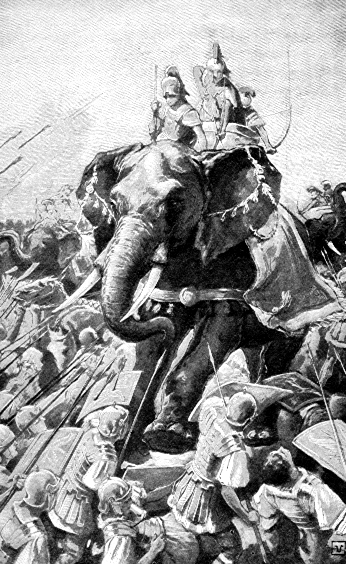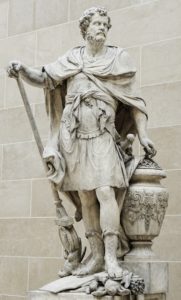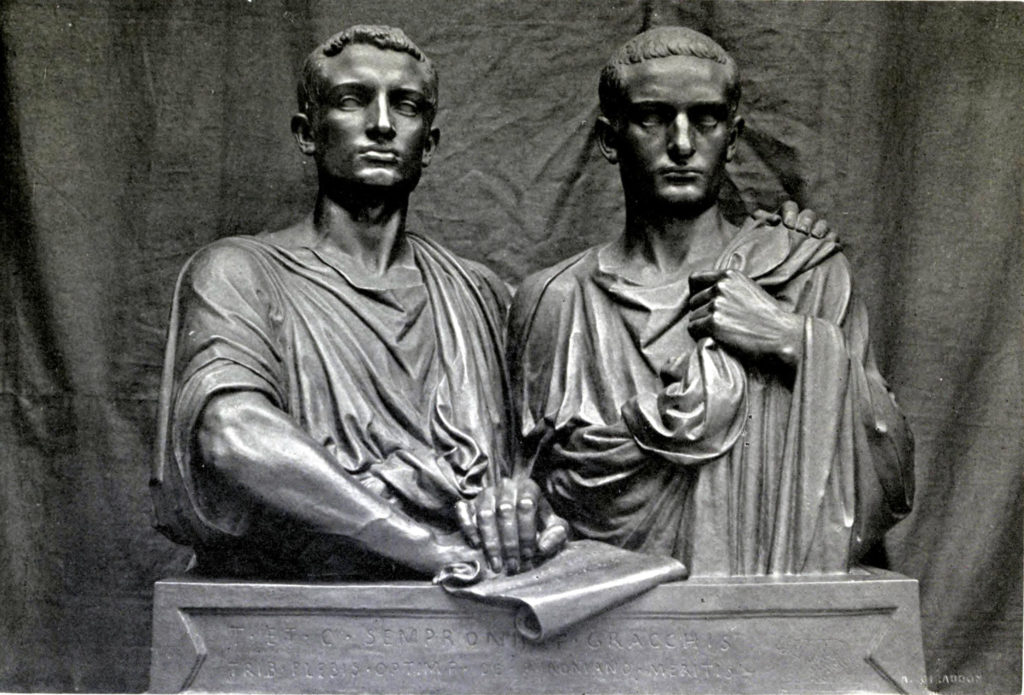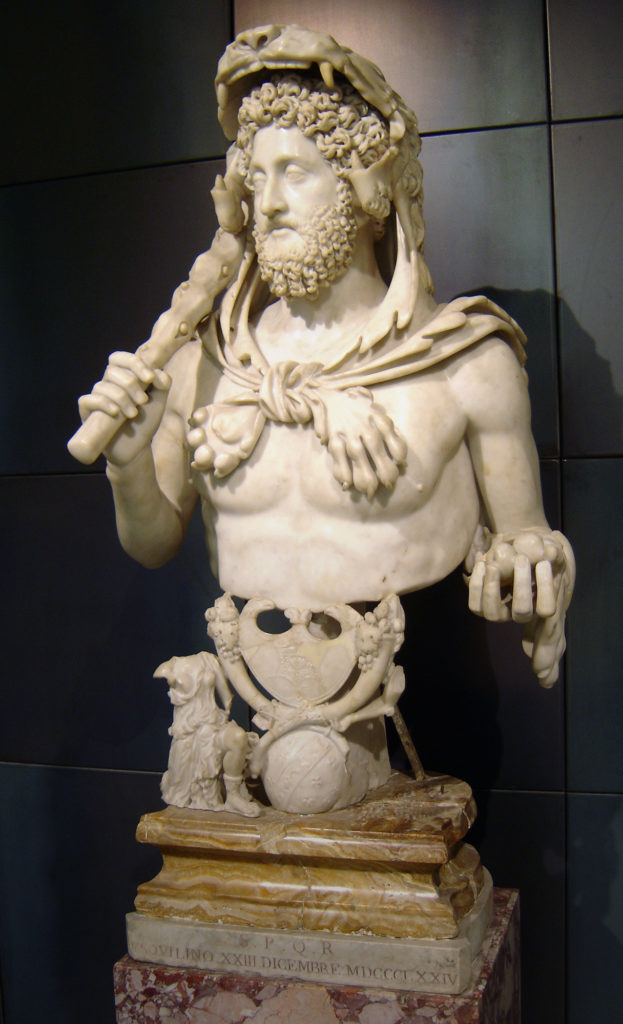A Very Basic History of Rome
According to legend, Rome was founded in 753 BCE, on April 21st (Rome’s birthday was celebrated at a festival called the Parilia[2] each year). It took its name from its founder, Romulus, who was also its first king – and also, again according to legend, the first person to hold a triumph (a type of military parade; see here for more details). It remained a monarchy until 509 BCE, with Etruscan kings ruling from the fifth monarch, L. Tarquinius Priscus, on. The last king, Lucius Tarquinius Superbus, was driven out of Rome after his son raped Lucretia, the wife of a Roman nobleman; the story of Etruscan kings and the expulsion of those kings reflects Rome’s early dominance by the Etruscans to the north.
In its early days Rome was a small city-state, surrounded by other far more powerful and developed civilizations and powers, especially the Etruscans to the north and the Greeks of Magna Graecia to the South. It had ties and alliances with other Latin speaking city-states. However, gradually Rome became the dominant power in central Italy, scoring major victories over its neighbours and acquiring more and more manpower along the way. Rome’s history after the fall of the kings is usually divided into four periods: the Early Republic; the Mid-Republic; the Late Republic; and the Imperial Period.
The Early Republic (509-275)

After expelling the kings, Rome was governed by elected officials, the consuls, two of whom were elected each year; there was also a Senate of varying numbers. This was a period marked by patrician control of the Roman government, although that control was challenged during the conflict of the orders, which resulted in plebeians gaining more rights to hold various offices and authority. The praetorship was created, as was the office of the Tribune of the Plebs in 494 BCE; the job of the latter was to protect the interests of the plebeians, and although it did not hold imperium, its holders had a powerful right to veto any legislation that they believed not to be in the interest of the people. Rome joined the Latin League, a league of Latin speaking states in central Italy, in 493 BCE after defeating the forces of the League at the Battle of Lake Regillus; the league was dissolved in 338 after the Latin War between Rome and the League. In 281 Rome faced off against King Pyrrhus of Epirus who had come to support Greek cities in the south of Italy worried about Roman expansion; from the war with Pyrrhus came the first elephants to be brought to Rome.
The Mid-Republic (274-133)

On the whole, spectacles of the type this book covers date from the Mid-Republic on, and it is those periods where our sources begin to place gladiatorial shows and other forms of spectacle (except chariot racing, which dated back to the time of the monarchy). During this period Rome conquered the entire peninsula of Italy, scoring victories over the Greek cities to the south. This was also a period of intense Hellenization: an influx of Greek slaves and culture led to the creation of Latin literature[3] and to an elite which embraced Greek culture and art and used those as a major building block in aristocratic identity. Rome’s expansion led it into conflict with Carthage, a large mercantile empire based in Carthage (modern Tunis). Its first overseas province was the island of Sicily, which it gained as a result of victory over the Carthaginians in the First Punic War. It took advantage of internal weaknesses in Carthage after that war to seize Corsica and Sardinia in an action of great legal dubiousness that Carthaginians deeply resented. Further conflict with Carthage ensued: the great Carthaginian general Hannibal Barca brought war to Italy during the Second Punic War (216-202 BCE), and inflicted a number of great defeats on Rome, many of which Rome dealt with by holding games or spectacles aimed at appeasing the gods; Carthage lost that war at the battle of Zama in 202 BCE. Carthage was wiped out as in 146 BCE, when Romans picked a fight, besieged the city, and then razed it to the ground. In the same year they captured and destroyed of Corinth, a Greek city which was later refounded as a Roman colony by Julius Caesar, and the Romans were the dominant power of much of the Mediterranean.
The Late Republic (133-43 or 31 BCE)
In 133 a Tribune of the Plebs by the name of Tiberius Gracchus, a man of an ancient and famous family, was lynched by a senatorial mob for trying to enact a series of agrarian reforms which would have affected many of the elite who rented large land holdings from the state.[4] A new and violent phase of Roman politics had started and murder became an increasingly popular political tool. In 122 Tiberius’ brother, Gaius, who also held the position of Tribune of the Plebs, was murdered by a senatorial faction.[5] The next hundred years was to see Rome expand her power, gobbling up Hellenistic kingdoms in the east and conquering Gaul, much of Spain, and (briefly) part of Britain. It was also to see her beset by a series of internal crises and civil wars as various warlords fought over the rewards of empire.
Marius (156-86 BCE), a novus homo who went from relative obscurity to hold the consulship seven times, fought it out with Lucius Cornelius Sulla, one of his ex-quaestors,[6] in a Civil War which saw Sulla march on Rome with his army (88 BCE). Elite competition was fierce and often bloody, but to gain offices one needed to appeal to the people by providing increasingly elaborate spectacles, which exploded in size and expense. Further civil wars were fought between Julius Caesar and his erstwhile son-in-law Pompey the Great, who led the senatorial faction (49-45 BCE), and between Octavian and Mark Antony (32-30 BCE), finally resulting in Octavian being the sole ruler of the Roman world, and the first Roman emperor, ruling under the name Augustus.

The Empire (31 BCE-476 CE)

Octavian’s victory at the Battle of Actium in 31 BCE resulted in one man rule; because the Romans found the name of king reprehensible, Octavian styled himself as princeps,[7] rather than king. He took the title of Augustus in 27 BCE; the Julio-Claudian dynasty retained control of the empire until the suicide of Nero in 68 CE, whereupon they were replaced after a period of civil war and three short-lived emperors by Vespasian and the Flavian dynasty; it was the Flavians who built the Colosseum from proceeds from the First Roman-Jewish War (66-73 CE). After this a succession of short dynasties ruled the empire and for each emperor (with the exception of Tiberius, Augustus’ successor, who hated to spend money) spectacle formed a vital way to communicate with and appease the people. Over time, spectacles increased in size and lavishness, involving thousands of animals and people; some emperors such as Nero and Commodus took spectacle one step further by taking part in them, and getting criticized by our sources for it. Many other emperors were dedicated fans, supporting different chariot factions, actors, gladiators, and gladly pouring money into spectacles of all sorts.
The empire used its vast resources and networks to bring people, animals, and materials to Rome, employing the army to help along with networks of indigenous hunters and trackers. Spectacles might have been free for many Romans, but they came at a significant cost to the societies that were called on to supply them.
Media Attributions
- Pyrrhus_and_his_Elephants is licensed under a Public Domain license
- Hannibal Slodtz Louvre MR2093 © Sébastien Slodtz is licensed under a Public Domain license
- The Gracchi © Jean-Baptiste Claude Eugène Guillaume is licensed under a Public Domain license
- Commodus as Hercules © Photo by Ricardo André Frantz is licensed under a CC BY-SA (Attribution ShareAlike) license
- The one given by Wikipedia is fine. ↵
- This was dedicated to god Pales, a shepherd god of indeterminate gender. ↵
- Invented, according to our records, more or less by Livius Andronicus, originally a Greek prisoner of war from Tarentum, a Greek city state in the south of Italy. ↵
- They were charged very little, and even then most of them didn't pay. ↵
- The Gracchi Brothers are often seen as heroes by those who stuggled to get land off the rich, not just in Rome but much later. ↵
- A quaestor was an elected position – holding this allowed one to sit in the Senate; they were in charge of financial affairs for governors or the military. ↵
- This is where we get the word prince from, but it was not a royal title. It was an informal Latin title given originally to the most important man in a group, the principal or leader, among them. ↵
A people that controlled much of central Italy; at one point, even over Rome. They were eventually conquered by the Romans, and some Romans claimed descent from them. They spoke and wrote a non-Latin language.
The name given to the parts of the South of Italy and Sicily colonized by the Greeks; it contained many important cities which were originally founded by Greek settlers, including Neapolis (Naples), Tarentum (Tarento), and Syracuse.
The chief military and civilian commander of Rome. Two were elected each year and competition to become consul was incredibly intense as it represented the apex of a political career. After their term in office consuls could go on to be governors of provinces, where, under the Republic, they were wont to rob the provincials blind in order to recoup the costs of their political campaigns.
The second most senior position in the cursus honorum, there was originally only one, but the number expanded to 8 and then 16 as the needs of the administration demanded more and more magistrates.
A magistracy without imperium, it was founded in 494 BCE to protect the interests of the plebs. It was a sacrosanct office – meaning that harming one in office was a capital offence – and from 449 BCE onwards any tribune could veto any legislation that he felt was not in the interest of the people. Originally there were only two, but that number expanded to ten; their powers were circumscribed by the Dictator Sulla, but quickly restored by Pompey the Great in 54 BCE.
The power to command legions and the army. It was only held by certain magistracies, such as the consulship and praetorship. Holders had the right to be attended by lictors, the number of which varied according to the seniority of the magistracy.
A city in North Africa in modern Tunisia, it was the head of the Carthaginian Empire. It was destroyed by Rome in 146 BCE when they finally defeated the Carthaginians, but refounded in the 40s BCE as a Roman colony by Julius Caesar. It became an important urban and cultural centre with a population eventually of about 500,000.
Novus Homo, literally translating from Latin to English as “new man” was someone who served in the senate but had no relatives or ancestors who had done so. This figure would consequently be a new man in Roman politics. A selection of significant figures in Roman history who were novus homo includes Cato the Elder, who was elected as Consul for 195 BCE, Gaius Marius, who first served as Consul in 107 BCE (and 104-100 BCE and 89 BCE subsequently), and Cicero, who served as Consul in 63 BCE.
Nero Claudius Caesar Augustus Germanicus ruled 54-68CE and was the last of the Julio-Claudians. Nero is remembered as a manic and artistically obsessed unRoman emperor. He is portrayed as one of the prime examples of how not to act as an emperor. Common portraiture characteristics include an overly large fat face, a chin-beard, unkempt hair, and a general ugly appearance .
This is a stub and will be updated soon.

